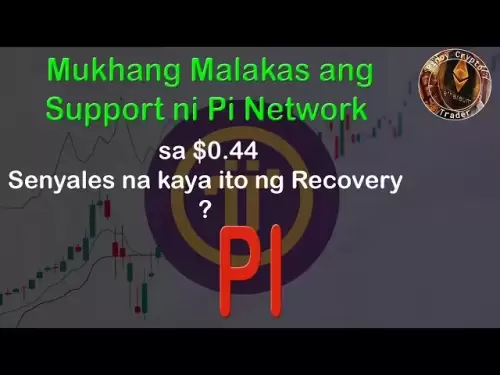-
 Bitcoin
Bitcoin $108,708.8110
0.60% -
 Ethereum
Ethereum $2,561.6057
1.91% -
 Tether USDt
Tether USDt $1.0001
-0.03% -
 XRP
XRP $2.2795
0.57% -
 BNB
BNB $662.2393
1.00% -
 Solana
Solana $153.1346
3.74% -
 USDC
USDC $1.0000
0.00% -
 TRON
TRON $0.2877
0.97% -
 Dogecoin
Dogecoin $0.1710
3.93% -
 Cardano
Cardano $0.5871
1.61% -
 Hyperliquid
Hyperliquid $39.6663
1.68% -
 Sui
Sui $2.9032
0.79% -
 Bitcoin Cash
Bitcoin Cash $496.1879
1.71% -
 Chainlink
Chainlink $13.5807
3.01% -
 UNUS SED LEO
UNUS SED LEO $9.0777
0.61% -
 Stellar
Stellar $0.2514
4.51% -
 Avalanche
Avalanche $18.1761
1.86% -
 Shiba Inu
Shiba Inu $0.0...01173
1.72% -
 Toncoin
Toncoin $2.8010
-4.23% -
 Hedera
Hedera $0.1594
3.21% -
 Litecoin
Litecoin $87.0257
-0.53% -
 Monero
Monero $319.1217
1.79% -
 Polkadot
Polkadot $3.3853
0.68% -
 Dai
Dai $0.9999
-0.01% -
 Ethena USDe
Ethena USDe $1.0003
0.02% -
 Bitget Token
Bitget Token $4.3420
-0.97% -
 Uniswap
Uniswap $7.3772
1.39% -
 Aave
Aave $286.6277
5.61% -
 Pepe
Pepe $0.0...09994
2.33% -
 Pi
Pi $0.4589
1.76%
How to adjust positions when SUI's implied volatility rises?
When SUI's implied volatility rises, traders should adjust positions by reducing size, using stop-loss orders, and considering options to manage risk and capitalize on volatility.
Apr 25, 2025 at 06:08 am
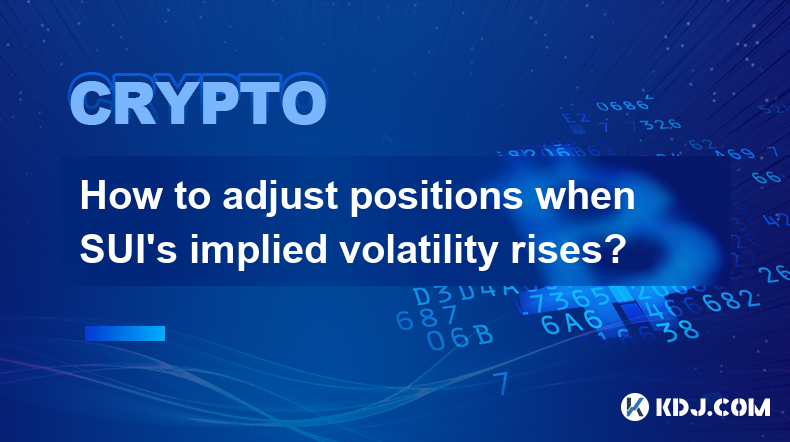
When SUI's implied volatility rises, it's crucial for traders to adjust their positions to manage risk and potentially capitalize on the increased volatility. Implied volatility (IV) is a measure of the market's expectation of a cryptocurrency's price fluctuation, and a rise in SUI's IV can signal upcoming significant price movements. Here's a detailed guide on how to adjust your positions effectively.
Understanding Implied Volatility and SUI
Implied volatility reflects the market's forecast of a likely movement in SUI's price. When IV rises, it typically means that the market expects larger price swings, which can be both an opportunity and a risk. SUI, being a relatively new cryptocurrency, might experience higher volatility compared to more established assets. Understanding the specific factors driving SUI's IV, such as market sentiment, upcoming events, or macroeconomic conditions, is essential before making any adjustments.
Assessing Your Current Position
Before making any adjustments, it's important to assess your current position in SUI. This involves reviewing your holdings, the size of your positions, and your risk tolerance. If you are holding long positions in SUI, a rise in IV might expose you to higher risk, whereas if you are holding short positions, it could present an opportunity to profit from increased volatility.
Adjusting Long Positions
If you hold long positions in SUI and notice a rise in IV, consider the following adjustments:
- Reduce Position Size: Lowering your exposure to SUI can help mitigate potential losses if the price drops due to increased volatility. You might decide to sell a portion of your SUI holdings to reduce your position size.
- Use Stop-Loss Orders: Implementing stop-loss orders can protect your investment from significant downturns. Set a stop-loss at a price level that you are comfortable with, ensuring that if SUI's price falls beyond this point, your position will be automatically sold.
- Hedging with Options: If available, consider purchasing put options on SUI to hedge your long position. A put option gives you the right to sell SUI at a predetermined price, providing a safety net if the price declines sharply.
Adjusting Short Positions
For those holding short positions in SUI, a rise in IV could potentially be advantageous. Here are some adjustments to consider:
- Increase Position Size: If you are confident in your bearish outlook on SUI, you might choose to increase your short position to capitalize on the anticipated downward price movement. However, this should be done cautiously, as increased volatility can lead to unpredictable price swings.
- Set Profit Targets: Establishing clear profit targets can help you lock in gains if the price of SUI moves in your favor. Decide on a price level at which you will close your short position to realize profits.
- Use Stop-Loss Orders: Similar to long positions, setting stop-loss orders on your short positions can limit potential losses if the price of SUI rises unexpectedly. Determine a stop-loss price at which your short position will be automatically closed to prevent further losses.
Utilizing Options Strategies
Options can be a powerful tool for adjusting positions when SUI's IV rises. Here are some strategies you might consider:
- Straddles and Strangles: These strategies involve buying both call and put options on SUI. A straddle involves options with the same strike price, while a strangle uses different strike prices. Both strategies can profit from significant price movements in either direction, making them suitable for periods of high volatility.
- Iron Condors: This strategy involves selling an out-of-the-money call and put while simultaneously buying a further out-of-the-money call and put. An iron condor can generate income if SUI's price remains within a certain range, which might be appealing if you expect volatility to increase but the price to remain relatively stable.
Monitoring and Reassessing
After making adjustments to your positions, it's crucial to continuously monitor the market and reassess your strategy. Keep an eye on SUI's IV, price movements, and any news or events that could impact the cryptocurrency. Be prepared to make further adjustments if necessary, as the market can change rapidly.
FAQs
Q: How often should I check SUI's implied volatility?
A: It's advisable to check SUI's implied volatility daily, especially during periods of high market activity or when significant events are expected. Regular monitoring helps you stay informed and ready to adjust your positions as needed.
Q: Can I use technical analysis to predict SUI's price movements when IV rises?
A: While technical analysis can provide insights into potential price movements, it should be used in conjunction with other factors, such as fundamental analysis and market sentiment. High IV can lead to unpredictable price swings, so relying solely on technical indicators might not be sufficient.
Q: Are there any tools or platforms that can help me track SUI's implied volatility?
A: Yes, several platforms offer tools for tracking implied volatility. For instance, cryptocurrency data providers like CoinGecko and CoinMarketCap often provide IV data, and trading platforms like Binance and Coinbase may offer IV indicators as part of their advanced trading tools.
Q: How does SUI's implied volatility compare to other cryptocurrencies?
A: SUI's implied volatility can be higher or lower than other cryptocurrencies depending on various factors, including its market size, liquidity, and the nature of upcoming events. Comparing SUI's IV to that of more established cryptocurrencies like Bitcoin or Ethereum can provide context, but remember that each cryptocurrency has its unique characteristics and market dynamics.
Disclaimer:info@kdj.com
The information provided is not trading advice. kdj.com does not assume any responsibility for any investments made based on the information provided in this article. Cryptocurrencies are highly volatile and it is highly recommended that you invest with caution after thorough research!
If you believe that the content used on this website infringes your copyright, please contact us immediately (info@kdj.com) and we will delete it promptly.
- Bitcoin Wallet Hack? Coinbase Exec Sounds the Alarm on $8B Whale Movement
- 2025-07-07 18:30:12
- Mercado Bitcoin, Tokenization, and XRP Ledger: A Latin American Power Play
- 2025-07-07 18:30:12
- XYZVerse, Wall Street, and the Crypto Upswing: What's the Deal?
- 2025-07-07 19:10:12
- AI, Web3, and Communities: Building the Future Together
- 2025-07-07 19:10:12
- AurealOne: A Promising Early-Stage Metaverse Project
- 2025-07-07 19:15:12
- Dogecoin Price: Crypto Market Analysis and the Musk Effect
- 2025-07-07 19:50:12
Related knowledge
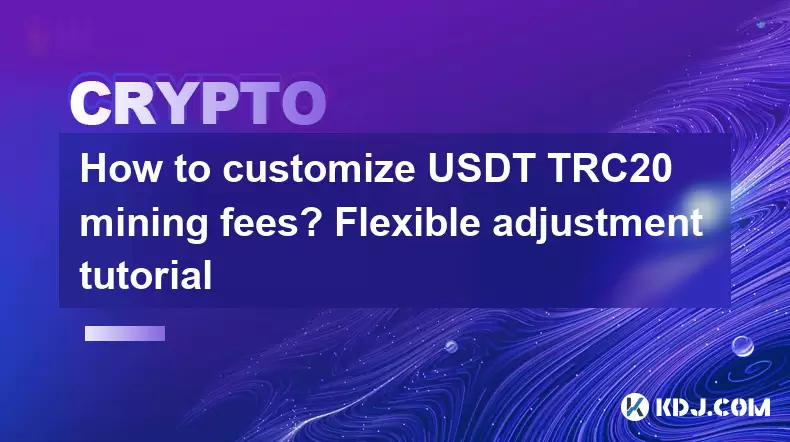
How to customize USDT TRC20 mining fees? Flexible adjustment tutorial
Jun 13,2025 at 01:42am
Understanding USDT TRC20 Mining FeesMining fees on the TRON (TRC20) network are essential for processing transactions. Unlike Bitcoin or Ethereum, where miners directly validate transactions, TRON uses a delegated proof-of-stake (DPoS) mechanism. However, users still need to pay bandwidth and energy fees, which are collectively referred to as 'mining fe...
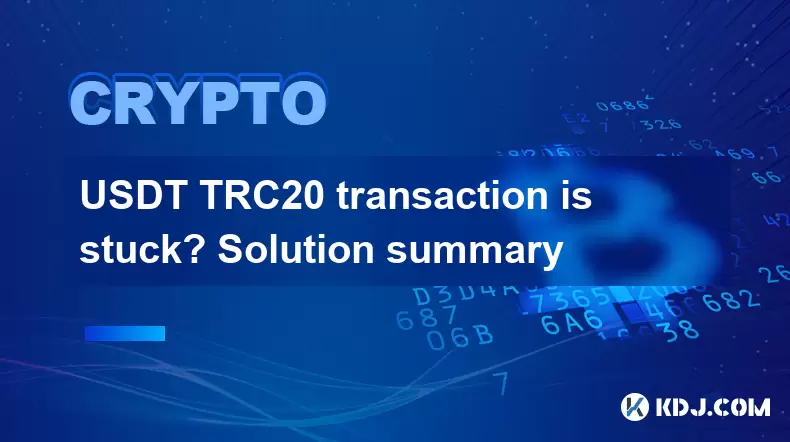
USDT TRC20 transaction is stuck? Solution summary
Jun 14,2025 at 11:15pm
Understanding USDT TRC20 TransactionsWhen users mention that a USDT TRC20 transaction is stuck, they typically refer to a situation where the transfer of Tether (USDT) on the TRON blockchain has not been confirmed for an extended period. This issue may arise due to various reasons such as network congestion, insufficient transaction fees, or wallet-rela...
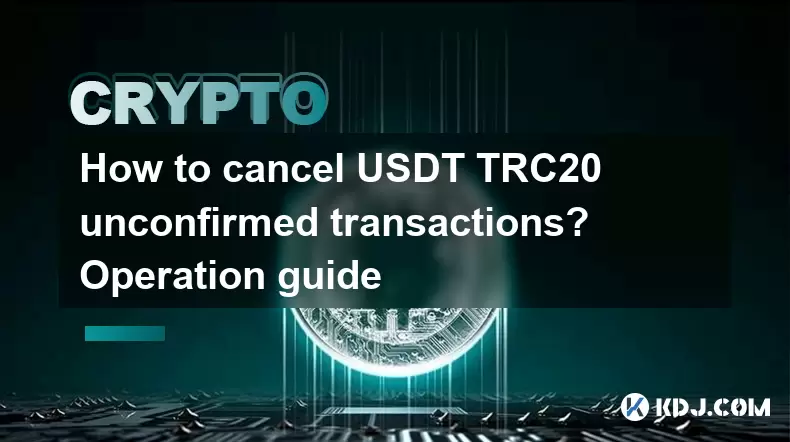
How to cancel USDT TRC20 unconfirmed transactions? Operation guide
Jun 13,2025 at 11:01pm
Understanding USDT TRC20 Unconfirmed TransactionsWhen dealing with USDT TRC20 transactions, it’s crucial to understand what an unconfirmed transaction means. An unconfirmed transaction is one that has been broadcasted to the blockchain network but hasn’t yet been included in a block. This typically occurs due to low transaction fees or network congestio...
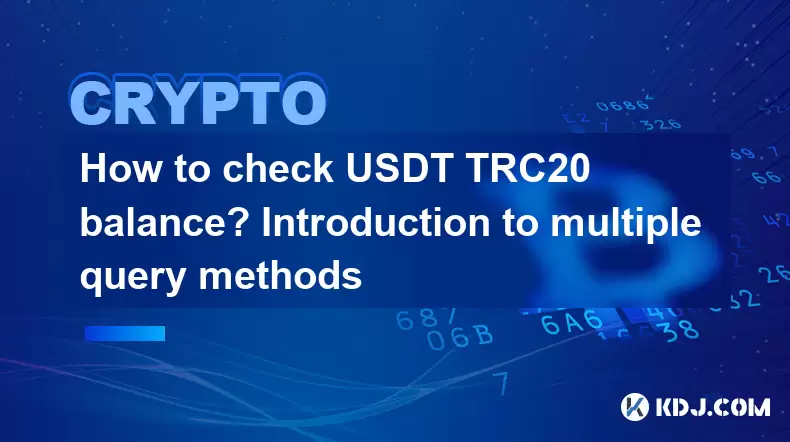
How to check USDT TRC20 balance? Introduction to multiple query methods
Jun 21,2025 at 02:42am
Understanding USDT TRC20 and Its ImportanceUSDT (Tether) is one of the most widely used stablecoins in the cryptocurrency market. It exists on multiple blockchain networks, including TRC20, which operates on the Tron (TRX) network. Checking your USDT TRC20 balance accurately is crucial for users who hold or transact with this asset. Whether you're sendi...
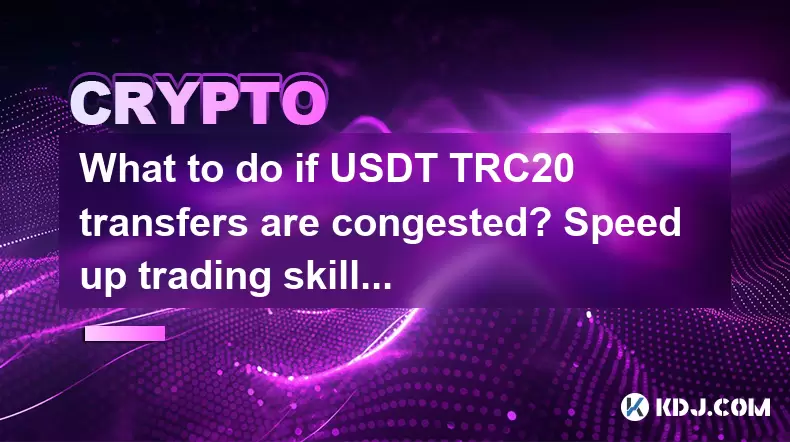
What to do if USDT TRC20 transfers are congested? Speed up trading skills
Jun 13,2025 at 09:56am
Understanding USDT TRC20 Transfer CongestionWhen transferring USDT TRC20, users may occasionally experience delays or congestion. This typically occurs due to network overload on the TRON blockchain, which hosts the TRC20 version of Tether. Unlike the ERC20 variant (which runs on Ethereum), TRC20 transactions are generally faster and cheaper, but during...
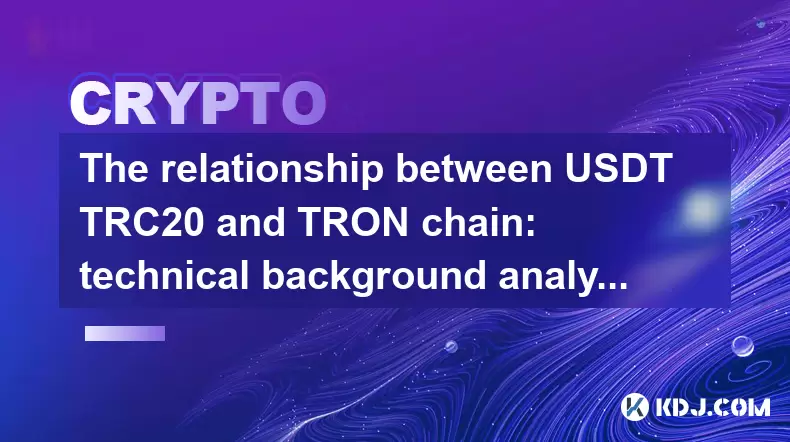
The relationship between USDT TRC20 and TRON chain: technical background analysis
Jun 12,2025 at 01:28pm
What is USDT TRC20?USDT TRC20 refers to the Tether (USDT) token issued on the TRON blockchain using the TRC-20 standard. Unlike the more commonly known ERC-20 version of USDT (which runs on Ethereum), the TRC-20 variant leverages the TRON network's infrastructure for faster and cheaper transactions. The emergence of this version came as part of Tether’s...

How to customize USDT TRC20 mining fees? Flexible adjustment tutorial
Jun 13,2025 at 01:42am
Understanding USDT TRC20 Mining FeesMining fees on the TRON (TRC20) network are essential for processing transactions. Unlike Bitcoin or Ethereum, where miners directly validate transactions, TRON uses a delegated proof-of-stake (DPoS) mechanism. However, users still need to pay bandwidth and energy fees, which are collectively referred to as 'mining fe...

USDT TRC20 transaction is stuck? Solution summary
Jun 14,2025 at 11:15pm
Understanding USDT TRC20 TransactionsWhen users mention that a USDT TRC20 transaction is stuck, they typically refer to a situation where the transfer of Tether (USDT) on the TRON blockchain has not been confirmed for an extended period. This issue may arise due to various reasons such as network congestion, insufficient transaction fees, or wallet-rela...

How to cancel USDT TRC20 unconfirmed transactions? Operation guide
Jun 13,2025 at 11:01pm
Understanding USDT TRC20 Unconfirmed TransactionsWhen dealing with USDT TRC20 transactions, it’s crucial to understand what an unconfirmed transaction means. An unconfirmed transaction is one that has been broadcasted to the blockchain network but hasn’t yet been included in a block. This typically occurs due to low transaction fees or network congestio...

How to check USDT TRC20 balance? Introduction to multiple query methods
Jun 21,2025 at 02:42am
Understanding USDT TRC20 and Its ImportanceUSDT (Tether) is one of the most widely used stablecoins in the cryptocurrency market. It exists on multiple blockchain networks, including TRC20, which operates on the Tron (TRX) network. Checking your USDT TRC20 balance accurately is crucial for users who hold or transact with this asset. Whether you're sendi...

What to do if USDT TRC20 transfers are congested? Speed up trading skills
Jun 13,2025 at 09:56am
Understanding USDT TRC20 Transfer CongestionWhen transferring USDT TRC20, users may occasionally experience delays or congestion. This typically occurs due to network overload on the TRON blockchain, which hosts the TRC20 version of Tether. Unlike the ERC20 variant (which runs on Ethereum), TRC20 transactions are generally faster and cheaper, but during...

The relationship between USDT TRC20 and TRON chain: technical background analysis
Jun 12,2025 at 01:28pm
What is USDT TRC20?USDT TRC20 refers to the Tether (USDT) token issued on the TRON blockchain using the TRC-20 standard. Unlike the more commonly known ERC-20 version of USDT (which runs on Ethereum), the TRC-20 variant leverages the TRON network's infrastructure for faster and cheaper transactions. The emergence of this version came as part of Tether’s...
See all articles























